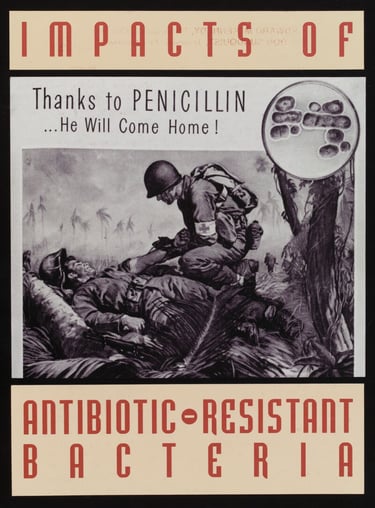The Bloody Engine: How War Powers Innovation and the Economy
FRESH BREWS
War is humanity’s most destructive force — yet history shows it can also be a strange driver of progress. The Bloody Engine: How War Powers Innovation and the Economy explores how conflict has both devastated societies and accelerated breakthroughs in technology, medicine, and industry. From penicillin to the Space Race, the paradox remains: in the fight to survive, nations often stumble into innovation that reshapes the world long after the battles end. Maybe war is not just pure evil, but a destructive force with complex nuances.


As of now, we seem to be moving toward a period of great geopolitical uncertainty — one that some fear could escalate into large-scale conflict. While none of us truly welcome the prospect of war, history shows that global leaders and nations often find themselves entangled in it, navigating circumstances that appear far beyond ordinary control.
When we think of war, most of us picture devastation, suffering, and loss. To put it more vividly, it is marked by the cries of the fallen and the silence that follows. That is true, and its weight cannot be denied. Yet, war is not only destruction. At times, it has also been a strange catalyst for rebirth. Conflict — or even the looming threat of it — often pushes societies into overdrive. Nations pour their energy into survival, sometimes setting aside traditional restraints. Economies, rather than collapsing outright, are forced into rapid and relentless motion. Development accelerates, and technology advances at a pace unimaginable in times of peace. Defence systems grow, industries adapt, and people unite. Not out of a pursuit of glory or conquest, but simply to endure.
The Destructive Side of War
This perspective is controversial, and understandably so. The costs of war are staggering. Economists usually break them down into three parts: (1) the opportunity cost of resources used in fighting, (2) the destruction of human lives and capital, and (3) the reduction of GDP per capita during and after the conflict.
Take the Cold War, for example. It imposed heavy economic burdens through military spending, trade disruptions, and inefficiencies in planned economies. The arms race consumed enormous resources, while the division of the world into blocs stifled trade and growth. Ultimately, economic stagnation contributed to the collapse of the Soviet Union — a reminder that war can just as easily unravel a system as accelerate it.
Defining and measuring the economic impact of war, however, has always been difficult. Datasets like Correlates of War (Small and Singer, 1982) or those from the Uppsala Conflict Data Program (UCDP) and Peace Research Institute Oslo (PRIO) use thresholds of battle deaths to classify conflicts, but such measures can be misleading. Advances in medical care, for instance, lower mortality rates without reducing the scale of fighting.
Economically, war presents a paradox. Weapon production adds to GDP, but destruction and loss of life are not directly subtracted. In some cases, wartime production reduces unemployment and spurs growth, while in others, the destruction of infrastructure, human capital, and trade opportunities drags economies downward.
From this view, war can be seen as both a destructive drain and, under certain conditions, a short-term stimulant to productivity.
The Forgotten Growth That War Fuels
Despite its destructive nature, history shows that war often accelerates scientific and technological progress. This isn’t limited to weapons or defence systems. Under pressure, governments and industries redirect resources into research and development, leading to breakthroughs in medicine, communication, logistics, and more.
World War II, for instance, saw the rapid advancement of radar, early computers like the ENIAC, rocketry, and the mass production of penicillin. Even devices like the cavity magnetron — crucial for radar — later transformed everyday life, laying the foundation for technologies as common as the microwave oven.
The Cold War, too, fostered transformative innovation. The internet, initially developed as a defence project in the 1960s, grew from the same climate of global tension.
Historical Proof: WWII, Penicillin, and the Space Race
Consider the Space Race. On October 4, 1957, the Soviet Union launched Sputnik, the world’s first artificial satellite. Though rudimentary, its success was a powerful signal of technological capability. The United States responded swiftly, improving education in science and mathematics, launching its own satellite months later, and establishing NASA in 1958.
This competition, born of rivalry, culminated in the Apollo 11 moon landing in 1969 — an achievement that might have come far later without Cold War urgency.
Medicine also benefited. Alexander Fleming had discovered penicillin in 1928, but it wasn’t until World War II that large-scale production began, saving countless lives on and off the battlefield.
In each case, the pressures of war accelerated progress that reshaped civilian life long after the conflicts ended.
Conclusion: Can Progress Justify Conflict?
War, undeniably, carries immense human and economic costs. Yet, it also reveals something about human resilience. Under the direst pressure, societies often find ways to innovate, adapt, and push boundaries. Our instincts for survival — to endure and to advance — seem to thrive in such conditions.
With today’s unsettled global landscape, it is difficult to predict what the future holds. What can be said with some certainty, however, is that humanity has a long history of transforming even its darkest trials into engines of progress. Whether this can ever justify the devastation of conflict is another matter entirely, but the pattern remains: in surviving, we often discover new ways to thrive even in the most detrimental times.
